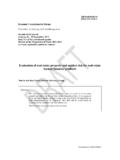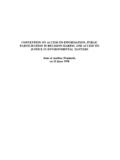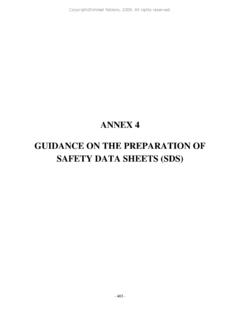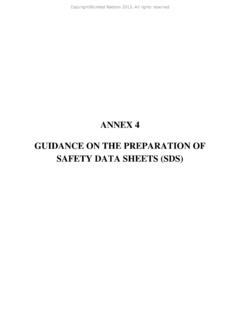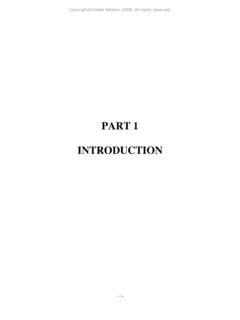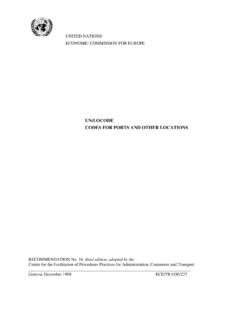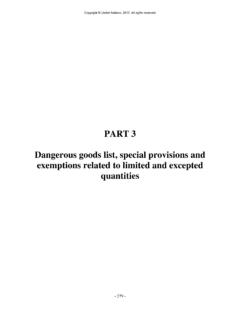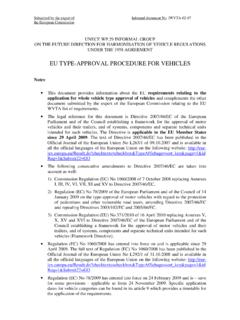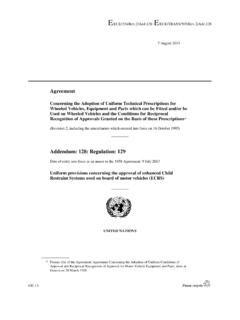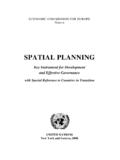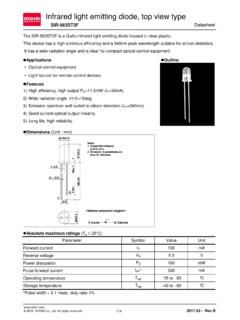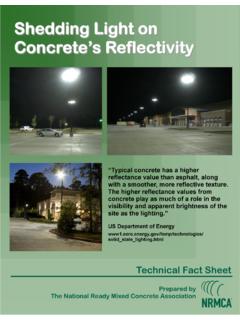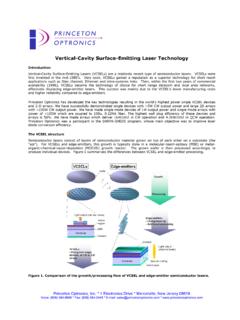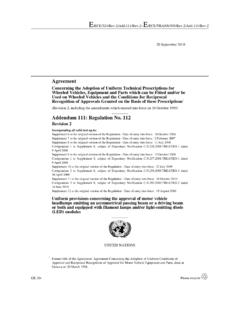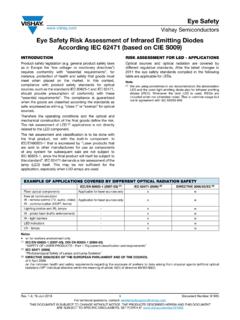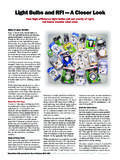Transcription of Agreement - UNECE
1 Agreement Concerning the Adoption of Uniform Technical Prescriptions for Wheeled Vehicles, Equipment and Parts which can be Fitted and/or be Used on Wheeled Vehicles and the Conditions for Reciprocal Recognition of Approvals Granted on the Basis of these Prescriptions* (Revision 2, including the amendments which entered into force on 16 October 1995) Addendum 52: Regulation No. 53 Revision 3 Incorporating all valid text up to: Supplement 9 to the 01 series of amendments - Date of entry into force: 15 October 2008 Supplement 10 to the 01 series of amendments - Date of entry into force: 24 October 2009 Corrigendum 1 to Supplement 10 to the 01 series of amendments - Date of entry into force: 11 November 2009 Supplement 11 to the 01 series of amendments - Date of entry into force: 9 December 2010 Supplement 12 to the 01 series of amendments - Date of entry into force: 23 June 2011 Supplement 13 to the 01 series of amendments - Date of entry into force: 28 October 2011 Supplement 14 to the 01 series of amendments - Date of entry into force: 15 July 2013 Uniform provisions concerning the approval of category L3 vehicles with regard to the installation of lighting and light-signalling devices UNITED NATIONS * Former title of the Agreement .
2 Agreement Concerning the Adoption of Uniform Conditions of Approval and Reciprocal Recognition of Approval for Motor Vehicle Equipment and Parts, done at Geneva on 20 March 1958. E/ECE/324 E/ECE/TRANS/505 7 August 2013 E/ECE/324 E/ECE/TRANS/505 3 Regulation No. 53 Uniform provisions concerning the approval of category L3 vehicles with regard to the installation of lighting and light-signalling devices Contents Page 1. Scope .. 4 2. Definitions .. 4 3. Application for approval .. 8 4. Approval .. 9 5. General specifications .. 10 6. Individual specifications .. 14 7. Modifications of the vehicle type or of the installation of its lighting and light-signalling devices .. 30 8. Conformity of production .. 30 9. Penalties for non-conformity of production .. 31 10. Production definitively discontinued .. 31 11. Transitional provisions .. 31 12. Names and addresses of Technical Services responsible for conducting approval tests, and of Type Approval Authorities.
3 31 Annexes 1 32 2 Arrangement of approval marks .. 35 3 Lamp surfaces, axis and centre of reference, and angles of geometric visibility .. 36 4 Forward visibility of red lights and rearward visibility of white lights .. 38 5 Control of conformity of production .. 39 6 Explanation about "the horizontal inclination", "the bank angle" and the angle " " .. 40 E/ECE/324 E/ECE/TRANS/505 4 1. Scope This Regulation applies to vehicles of category L31 with regard to the installation of lighting and light-signalling devices. 2. Definitions For the purpose of this Regulation: "Approval of a vehicle" means the approval of a vehicle type with regard to the number and mode of installation of the lighting and light-signalling devices; "Vehicle type" means a category of vehicles which do not differ from each other in such essential respects as: The dimensions and external shape of the vehicle; The number and position of the devices; The following shall likewise not be deemed to be "vehicles of a different type": Vehicles which differ within the meaning of paragraphs and above but not in such a way as to entail a change in the kind, number, position and geometric visibility of the lamps prescribed for the vehicle type in question.
4 And Vehicles on which lamps approved under one of the Regulations annexed to the 1958 Agreement , or lamps allowed in the country in which the vehicles are registered, are fitted, or are absent where their fitting is optional; "Transverse plane" means a vertical plane perpendicular to the median longitudinal plane of the vehicle; "Unladen vehicle" means a vehicle without a driver, or passenger, and unladen, but with its fuel tank full and its normal complement of tools; "Lamp" means a device designed to illuminate the road or to emit a light signal to other road users. Rear registration plate lamp and retro-reflectors are likewise to be regarded as lamps; "Equivalent lamps" means lamps having the same function and authorised in the country in which the vehicle is registered; such lamps may have different characteristics from those of the lamps with which the vehicle is equipped at the time of approval, on condition that they satisfy the requirements of this Regulation; "Independent lamps" means devices having separate illuminating surfaces, separate light sources and separate lamp bodies; "Grouped lamps" means devices having separate illuminating surfaces and separate light sources, but a common lamp body; 1 As defined in the Consolidated Resolution on the Construction of Vehicles ( ), document ECE/ , para.
5 2. - E/ECE/324 E/ECE/TRANS/505 5 "Combined" means devices having separate illuminating surfaces, but a common light source and a common lamp body; "Reciprocally incorporated" means devices having separate light sources or a single light source operating under different conditions (for example, optical, mechanical, electrical differences), totally or partially common illuminating surfaces and a common lamp body; "Driving-beam (main-beam) headlamp" means the lamp used to illuminate the road over a long distance ahead of the vehicle; "Passing-beam (dipped-beam) headlamp" means the lamp used to illuminate the road ahead of the vehicle without dazzling of causing undue discomfort to oncoming drivers and other road users; "Principal passing-beam (principal dipped beam)" means the dipped beam produced without the contribution of infrared (IR) emitters and/or additional light sources for bend lighting.
6 "Direction indicator lamp" means the lamp used to indicate to other road-users that the driver intends to change direction to the right or to the left; A direction indicator lamp or lamps may also be used according to provisions of Regulation No. 97. "Stop lamp" means the lamp used to indicate to other road-users to the rear of the vehicle that its driver is applying the service brake; "Rear-registration-plate illuminating device" means the device used to illuminate the space reserved for the rear registration plate; such a device may consist of several optical components; "Front position lamp" means the lamp used to indicate the presence of the vehicle when viewed from the front; "Rear position lamp" means the lamp used to indicate the presence of the vehicle when viewed from the rear; "Retro-reflector" means a device used to indicate the presence of a vehicle by the reflection of light emanating from a light source not connected to the vehicle, the observer being situated near the source; For the purpose of this Regulation, retro-reflecting number plates are not considered as retro-reflectors.
7 "Hazard warning signal" means the simultaneous operation of all of a vehicle's direction indicator lamps to show that the vehicle temporarily constitutes a special danger to other road users; "Front fog lamp" means the lamp used to improve the illumination of the road in case of fog, snowfall, rainstorms or dust clouds; "Rear fog lamp" means the lamp used to make the vehicle more easily visible from the rear in dense fog; "Daytime running lamp" means a lamp facing in a forward direction used to make the vehicle more easily visible when driving during daytime. "Light-emitting surface" of a "lighting device", "light-signalling device" or a retro-reflector means all or part of the exterior surface of the transparent material as declared in the request for approval by the manufacturer of the device on the drawing, see Annex 3; E/ECE/324 E/ECE/TRANS/505 6 "Illuminating surface" (see Annex 3); "Illuminating surface of a lighting device" (paragraphs.)
8 , and above) means the orthogonal projection of the full aperture of the reflector, or in the case of headlamps with an ellipsoidal reflector of the "projection lens", on a transverse plane. If the lighting device has no reflector, the definition of paragraph below shall be applied. If the light emitting surface of the lamp extends over part only of the full aperture of the reflector, then the projection of that part only is taken into account. In the case of a passing-beam headlamp, the illuminating surface is limited by the apparent trace of the cut-off on to the lens. If the reflector and lens are adjustable relative to one another, the mean adjustment should be used; In the case where any combination of a headlamp producing the principal passing-beam and additional lighting units or light sources designed to produce bend lighting are operated together, the individual illuminating surfaces, taken together, constitute the illuminating surface.
9 "Illuminating surface of a light-signalling device other than a retro-reflector" (paragraphs , , , , and above) means the orthogonal projection of the lamp in a plane perpendicular to its axis of reference and in contact with the exterior light-emitting surface of the lamp, this projection being bounded by the edges of screens situated in this plane, each allowing only 98 per cent of the total luminous intensity of the light to persist in the direction of the axis of reference. To determine the lower, upper and lateral limits of the illuminating surface, only screens with horizontal or vertical edges shall be used; "Illuminating surface of a retro-reflector" (para. above) means the orthogonal projection of a retro-reflector in a plane perpendicular to its axis of reference and delimited by planes continuous to the outermost parts of the retro-reflector's optical system and parallel to that axis.
10 For the purposes of determining the lower, upper and lateral edges of the device, only horizontal and vertical planes shall be considered; The "apparent surface" for a defined direction of observation means, at the request of the manufacturer or his duly accredited representative, the orthogonal projection of: Either the boundary of the illuminating surface projected on the exterior surface of the lens (a-b), Or the light-emitting surface (c-d), In a plane perpendicular to the direction of observation and tangential to the most exterior point of the lens (see Annex 3 to this Regulation); "Axis of reference" (or "reference axis") means the characteristic axis of the lamp determined by the manufacturer (of the lamp) for use as the direction of reference (H = 0 , V = 0 ) for angles of field for photometric measurements and for installing the lamp on the vehicle; "Centre of reference" means the intersection of the axis of reference with the exterior light-emitting surface; it is specified by the manufacturer of the lamp; E/ECE/324 E/ECE/TRANS/505 7 "Angles of geometric visibility" means the angles which determine the field of the minimum solid angle in which the apparent surface of the lamp must be visible.
